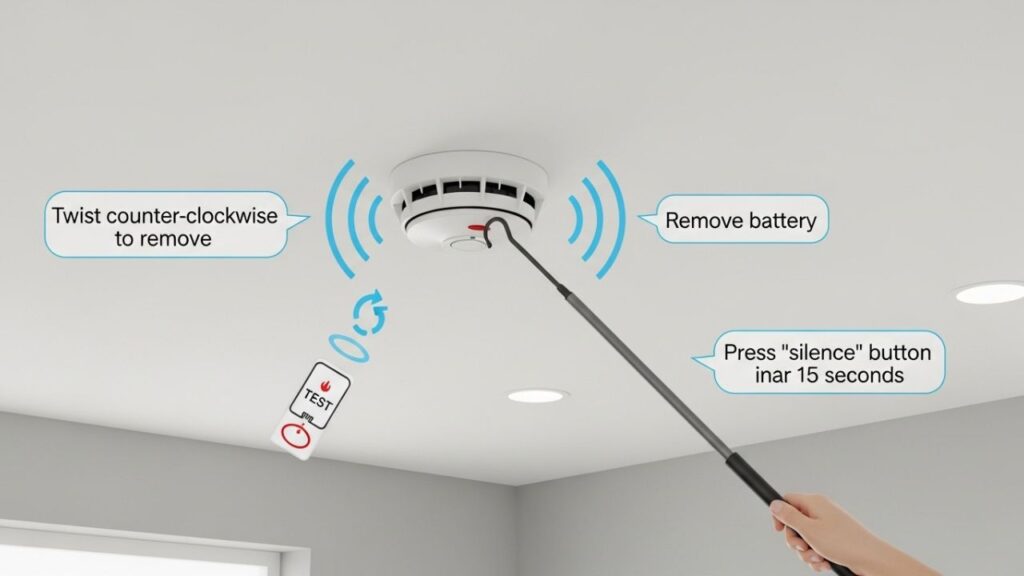Introduction
Few sounds are as annoying — or alarming — as a smoke detector that won’t stop beeping. Whether it’s a dead battery, dust build-up, or a system malfunction, knowing how to turn off smoke alarm beeping can save you frustration and keep your home safe. This step-by-step guide will help you identify why your smoke alarm is beeping and what you can do to silence it safely and effectively.
Understanding Why Smoke Alarms Beep
Before learning how to turn off smoke alarm beeping, it’s important to understand why it’s happening. Smoke alarms are designed to get your attention — and they beep for several reasons.
1. Low Battery Warning
A chirping noise every 30 to 60 seconds usually indicates that the battery is running low. Even hard-wired smoke alarms often have a backup battery that needs replacement once a year.
2. End of Life or Faulty Unit
Most smoke alarms last between 8 to 10 years. If yours has reached that point, it may start beeping to signal it needs replacement.
3. Dust or Dirt Buildup
If you notice random beeping even with a new battery, dust or insects inside the device could be triggering false alerts. Cleaning your smoke alarm can often fix this.
4. Power Supply Issues
For wired alarms, a power outage or loose wiring can cause the unit to beep intermittently.
5. Environmental Factors
Extreme temperatures, humidity, or steam (especially near kitchens and bathrooms) can set off your smoke alarm.
Step-by-Step: How to Turn Off Smoke Alarm Beeping
Now let’s go through the exact steps for how to turn off smoke alarm beeping and fix the underlying problem safely.
Step 1: Stay Calm and Identify the Beeping Unit
If multiple alarms are installed, locate which one is making the noise. Listen closely — most systems beep louder or flash a red light when active.
Step 2: Check for Smoke or Fire
Before silencing any alarm, make sure there’s no real danger. Walk around your home and ensure there’s no smoke, heat, or unusual smell. If you suspect a fire, leave immediately and call emergency services.
Step 3: Reset or Silence the Alarm
Most modern smoke alarms have a “silence” or “test/reset” button. Press and hold this button for about 15–20 seconds until the beeping stops.
-
For battery-operated units, you may need to remove the battery first.
-
For wired alarms, pressing the reset button on the main panel can help.
Step 4: Replace the Battery
If the alarm continues to chirp, replace the battery.
-
Remove the cover by twisting it counterclockwise.
-
Replace with a fresh 9-volt or AA battery as recommended by the manufacturer.
-
Reattach the cover and test the alarm by pressing the “test” button.
Step 5: Clean the Alarm
To prevent false beeping, gently vacuum or blow out the vents with compressed air. Avoid using cleaning sprays or water. Dust can interfere with the smoke sensor, triggering repeated beeps.
Step 6: Check the Age of Your Smoke Alarm
If the unit still beeps after battery replacement and cleaning, check the manufacture date (usually printed on the back). If it’s older than 10 years, it’s time to replace it entirely.
Step 7: Reset the Entire System (For Wired Units)
If you have interconnected alarms:
-
Turn off the power at your circuit breaker.
-
Remove one alarm and disconnect its wiring harness.
-
Wait 30 seconds.
-
Reconnect the wiring and restore power.
-
Press the reset button on each unit.
Common Mistakes to Avoid When Turning Off Smoke Alarm Beeping
Even when you know how to turn off smoke alarm beeping, many people make small errors that cause the problem to return. Here’s what not to do:
-
❌ Removing the battery and forgetting to replace it.
Doing this disables your alarm — leaving your home unprotected. -
❌ Ignoring random beeps.
These signals indicate issues like low batteries or malfunctioning sensors. Ignoring them can lead to dangerous failures. -
❌ Covering the alarm to silence it.
Never tape over or cover the speaker — this blocks future alerts and is unsafe. -
❌ Installing alarms too close to kitchens or bathrooms.
Steam and humidity can trigger false alarms; install units at least 10 feet away.
How Often Should You Replace or Maintain Smoke Alarms?
Proper maintenance helps reduce false alarms and ensures quick detection in case of fire.
-
Test alarms monthly. Press the “test” button until you hear a loud beep.
-
Replace batteries every 6–12 months. Many people do this during daylight saving time changes.
-
Clean alarms every 3–6 months. Remove dust and cobwebs using a soft brush or vacuum.
-
Replace the entire alarm every 8–10 years.
Following these habits means you won’t need to frequently worry about how to turn off smoke alarm beeping — because your unit will stay in good shape.
Types of Smoke Alarms and Their Beeping Patterns
Understanding your device type can help you troubleshoot more efficiently.
Ionization Smoke Alarms
These detect fast-flaming fires and are more sensitive to cooking smoke. They often chirp faster when batteries run low.
Photoelectric Smoke Alarms
These respond to slow, smoldering fires (like burning furniture). They may have a softer, intermittent chirp.
Combination Alarms
Many modern units use both technologies. Some include carbon monoxide detection, producing different beep patterns for each alert. Always refer to your manual to distinguish the tones.
When to Call a Professional
If you’ve tried all steps and the beeping continues, or if your smoke alarm is hard-wired into a home system, contact a qualified electrician. Persistent beeping may indicate electrical faults or sensor failure that only a professional can safely fix.
In apartment complexes, you may need to call building maintenance. Never attempt to rewire a connected alarm system unless you have proper training.
Preventing Future Smoke Alarm Beeping
To avoid constantly figuring out how to turn off smoke alarm beeping, prevention is key.
-
Use long-life lithium batteries for extended performance.
-
Install alarms away from cooking appliances and bathrooms.
-
Schedule routine checks every season.
-
Educate all household members on how to test and reset alarms.
-
Keep manufacturer manuals accessible for troubleshooting tips.
Final Thoughts
Knowing how to turn off smoke alarm beeping is more than just a convenience — it’s part of responsible home safety. While that persistent chirp can be irritating, it’s ultimately designed to protect you.
In most cases, the solution is simple: replace the battery, clean the unit, or reset it. But if the problem persists, replacing the entire alarm or calling a professional ensures your safety system remains reliable.
With regular maintenance and proper handling, you can enjoy peace of mind knowing your smoke alarm is doing its job — without the unnecessary noise.





